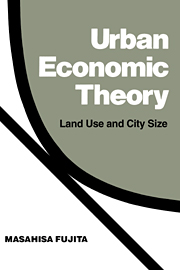Preface
Published online by Cambridge University Press: 23 December 2009
Summary
This book presents the basic theory of urban land use and city size in a unified framework. The residential location behavior of households is analyzed in a microeconomic framework, and the equilibrium and optimal patterns of residential land use are examined. In addition, the corresponding equilibrium and optimal city sizes are studied in a variety of contexts. Extensions of the theory to a general equilibrium framework (i.e., simultaneous determination of location of both households and firms) and to a dynamic framework will be considered in a planned second book.
The present book is an outgrowth of a series of lectures given to graduate students at the University of Pennsylvania over the past several years. Throughout the text, mathematical analyses are accompanied by intuitive explanations and diagrams. Hence, although this book is written primarily for graduate students (in the fields of urban economics, location theory, urban geography, and urban planning), any reader who has reasonable patience with mathematical notation will be able to follow the main body of the book.
My central purpose is to develop the existing theory of urban land use and city size in a manner that is accessible to students. To do so, I have attempted to unify the main results of the theory in terms of the bid rent function approach. The origin of this approach is quite old. Indeed, von Thünen (1826) created his original model of agricultural land use, which stands as a cornerstone of land use theory, using this approach.
- Type
- Chapter
- Information
- Urban Economic TheoryLand Use and City Size, pp. xi - xiiPublisher: Cambridge University PressPrint publication year: 1989



